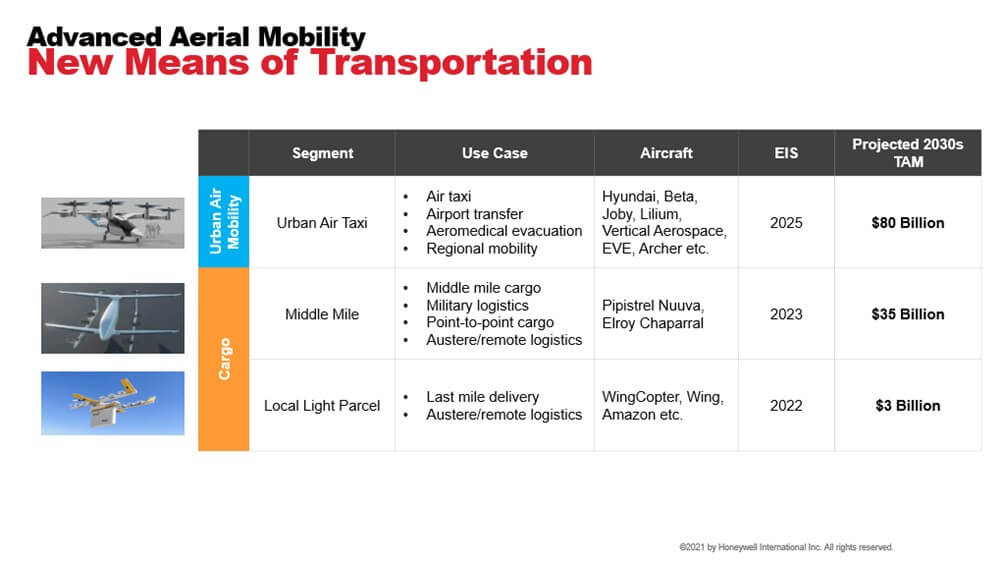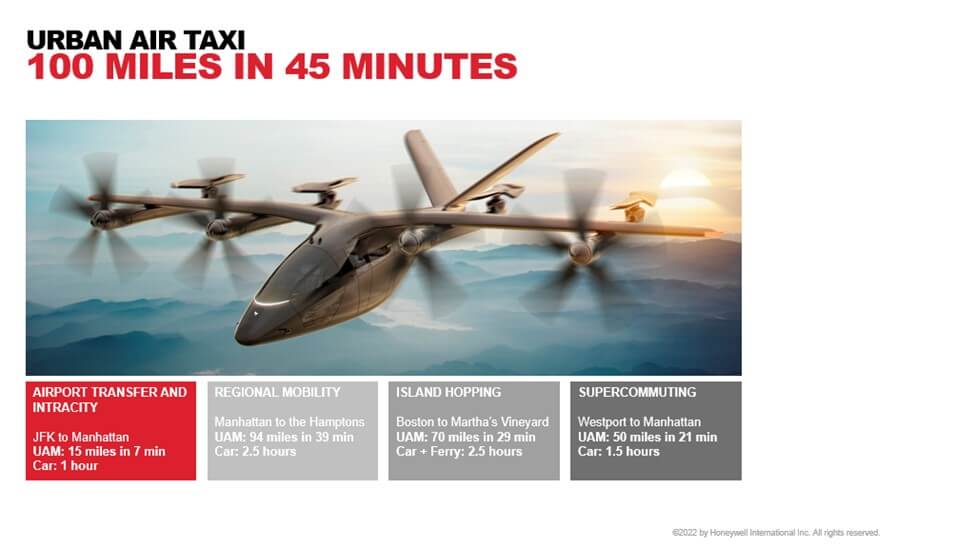
The News: With the unveiling of its new experience center in Phoenix, Arizona, Honeywell is providing key technology and a roadmap to the market to better understand the opportunities for next generation urban air mobility.
Honeywell Brings the Future of Urban and Advanced Aerial Mobility in Focus
Analyst Take: This week I had the opportunity to attend the grand opening of Honeywell’s Executive Briefing Center in Phoenix, Arizona to get updated on its development in the urban air mobility space. Honeywell is a staple in the commercial aerospace industry, providing its products and services to a wide array of manufacturers and carriers. However, this focused more on a portion of what lies ahead for aerospace.
The briefing and demos that I was able to participate in offered an interesting perspective on not just the critical technologies that will provide the company growth in aerospace, but a dynamic look at the innovation and economic impacts that this space has to look forward to in the coming decade.
It Starts With Breakthrough Initiatives
Over the past few years, Futurum Research has tracked Honeywell closely as the company has sought to expand its pedigree and market perception from large industrial to technology innovator.
While the market sentiment has evolved leaving Honeywell better positioned as a value company in the near term, it is important to note that the company is well diversified to straddle the line between value and growth with best of both worlds in its approach.
Honeywell CEO, Darius Adamczyk, has been outspoken about the company’s need to focus on breakthrough initiatives that take the company from its legacy reputation into the future. The past few years quantum computing has been a key example of this evolution. However, the company’s big bets on IoT and Edge with its Forge Software is another noteworthy example.
In short, these investment areas, to align more closely with secular growth trends, are set to enable the company to expand its TAM materially, while driving short term sales growth. While the breakthrough investments focus on five areas including the Forge line (HCE) and Quantum (Quantinuum), there are other areas like Cyber and Urban Air Mobility that are part of these efforts.

Urban Air Mobility Brings Tam to Honeywell and Economic Value to Society
The experience center provided a solid overview of Honeywell’s contribution to advanced and urban air mobility. This technology, which is essentially light aircrafts and drones that can transport people and goods more efficiently, can be recognized as a significant opportunity for Honeywell.
It is important to discern that now all advanced aerial mobility is created equal, but Honeywell’s key technologies and contributions in areas like on board computing, telematics and navigation, and policy will have the opportunity to contribute to a diverse set of opportunities that will bring more than $100 billion in TAM for Honeywell and the opportunity to participate in a market that will draw attention for ushering in the next era of mobility. I predict the TAM to be larger than what is suggested by Honeywell as I see the last mile opportunity being materially larger than what was shared in the graphic below.

While the eye catching technology that will evolve aerospace, like next generation avionics that function more like the “Tesla Tablet” rather than a cockpit full of dials, switches, and knobs, are going to dominate headlines and interest in this space, what caught my attention is the economics of advanced and urban aerial mobility.
Autonomous vehicles and next generation mobility on the ground has been a focal point as we seek to make cities more efficient. Removing congestion and enabling greater numbers to move in and out of urban centers are opposing forces and with today’s largely manual transportation systems there are endless bottlenecks.
On the ground, companies like Mobileye, Waymo, and Uber are aggressively looking to drive improved efficiency for mobility rather than just delivering autonomy. Bringing people into urban centers more rapidly reduces friction, creates economic opportunity and can help make housing more affordable by connecting cities and suburbs in more expansive ways.
However, congested cities and traffic mean difficult commutes, which makes economic value falter and reduces productivity. The political landscape of moving mobility forward has a lot of complexity and ground mobility has more than aerial, despite the fact that we are closer to being able to do autonomous transportation of humans on the ground.
I see the technology from Honeywell and its partners as instrumental in potentially moving forward a second type of mobility–which will be aerial. Higher costs are a certain barrier, but the potential subsidy of urban air mobility could create a meaningful way to move people faster and connect citizens, business, and government services more efficiently. Studies will be required to unpack the potential economic benefit, but the idea of a 7 minute air transfer from JFK to Manhattan as opposed to the typical 60-90 minutes during average traffic could be instrumental.

And finally, the ability to deliver goods and services autonomously is a huge economic opportunity. The evolution of this capability could expedite massive amounts of shipping of goods and services from our more traditional last mile parcels to larger middle mile cargo. Beyond speed, it would also play a part in decongestion of certain traffic, especially in urban centers. Trucks may move from hub to hub on the outside of a large urban center, but once it arrives, advanced aerial mobility could be a catalyst to smoothen supply chains and improve the safety profile on roads by helping remove congestion caused by large transit in small and dense urban areas.
Urban and Advanced Aerial Mobility Provide Promise for the Future
These ideas are only a handful of the economic opportunities that should entice and excite civilians and policy leaders as we head into the era of autonomy.
Flying delivery drones and robo taxis may feel like a scene from a futuristic sci-fi movie or an episode of the Jetsons. However, it is rapidly approaching and the next wave of technology is making the profile of autonomous air transit safer.
Honeywell continues to push its pedigree in the aerospace industry while creating growth opportunities in an area in which it specializes. An impressive set of demos with even bigger long-term economic implications. A market space to watch enthusiastically.
Disclosure: Futurum Research is a research and advisory firm that engages or has engaged in research, analysis, and advisory services with many technology companies, including those mentioned in this article. The author does not hold any equity positions with any company mentioned in this article.
Analysis and opinions expressed herein are specific to the analyst individually and data and other information that might have been provided for validation, not those of Futurum Research as a whole.
More insights from Futurum Research:
Honeywell Investor Day 2022: All Eyes on Expanding Market Share and Investor Profitability
Making Markets EP20: Honeywell Pivots to Tech as the Edge Opportunity Proves Massive
Image Credit: Honeywell
The original version of this post was first published on Futurum Research.
Daniel Newman is the Principal Analyst of Futurum Research and the CEO of Broadsuite Media Group. Living his life at the intersection of people and technology, Daniel works with the world’s largest technology brands exploring Digital Transformation and how it is influencing the enterprise. From Big Data to IoT to Cloud Computing, Newman makes the connections between business, people and tech that are required for companies to benefit most from their technology projects, which leads to his ideas regularly being cited in CIO.Com, CIO Review and hundreds of other sites across the world. A 5x Best Selling Author including his most recent “Building Dragons: Digital Transformation in the Experience Economy,” Daniel is also a Forbes, Entrepreneur and Huffington Post Contributor. MBA and Graduate Adjunct Professor, Daniel Newman is a Chicago Native and his speaking takes him around the world each year as he shares his vision of the role technology will play in our future.

